Articles of 2006
One-Punch Knockouts
Countless fans and more than a few writers often have been looking elsewhere when what is the most dramatic moment in boxing occurred – a one-punch knockout. It is a punch that not only puts an exclamation point to a fight, but also to the story surrounding the fight. After 12 rounds of his challenge to heavyweight champion Jersey Joe Walcott on Sept. 23, 1952, in Municipal Stadium at Philadelphia, unbeaten Rocky Marciano needed a knockout to win.
THE SCENE (13th round) – Not much is happening when Marciano backs Walcott to the ropes. Both fighters start throw right hands. Before Walcott's can land Marciano's crashes against the champion's jaw. Walcott slumps to the canvas, with one arm draped over a rope, where he is counted out. A count is not necessary.
“Marciano beat Walcott to the punch,” Jesse Abramson wrote in the New York Herald-Tribune. “It was a simple as that.” A.J. Liebling, in the New Yorker, called the punch “a model of pugilistic concision.” After 12 rounds, referee Charlie Daggert had it 7-4-1, Judge Zach Clayton saw it 8-4, and judge Pete Tomasco had it 7-5, all for Walcott. That meant that if Marciano had won the last three rounds, Daggert would have scored the fight a draw at 7-7-1, Clayton would have favored Walcott 8-7 and Tomasco would have had Marciano winning 8-7. Walcott would have kept the title on a draw.
* * *
Gene Fullmer could not believe what was he was seeing when he looked at Sugar Ray Robinson's corner before the sixth round of their middleweight title fight in Chicago Stadium on May 1, 1957.
Many years later he recalled the scene: “Robinson was in the corner jumping up and down, and I thought he's in marvelous condition. How come he's doing exercises between rounds?” Robinson was celebrating, not exercising.
THE SCENE (fifth round) – Fullmer opens the round with some lefts to the body. They exchange short punches inside, then clinch. There are some boos when Fullmer hits Robinson as they break from a clinch. Robinson fires several jabs to the head. Fullmer lunges toward Robinson and gets caught with a left hook to the jaw that drops him for the 10-count.
“His jaw looked a big as any of the jaws on the Mount Rushmore monuments,” Robinson said in “Sugar Ray”, his 1970 autobiography written with Dave Anderson.
It was the fourth time Robinson, a 3-1 underdog, won the middleweight championship. He had lost it to Fullmer on a decision four months earlier.
* * *
The left hook made Jersey Joe Walcott the oldest heavyweight champion at that time. It enabled Floyd Patterson to become the first man to regain the heavyweight title. It made Mike Tyson the youngest heavyweight champ.
Ezzard Charles' title defense against Walcott on July 18, 1951, at Forbes Field in Pittsburgh was called the “Why Fight.” Why was it being held? The 37-year-old Jersey Joe had already failed to win the heavyweight title four times – losing a controversial decision to Joe Louis, getting knocked out by Louis and losing two decisions to Charles.
THE SCENE (seventh round) – The two men are sparring when Walcott, a 6-1 underdog, crashes left hook to the jaw. The crowd of 28,282 – many people having troubling believing what just happened – roars to its feet as Charles falls face down, his gloved fists under him. He struggles to his knees as the count reaches 10. Walcott, overcome with emotion, drops to his knees. He tries to talk into a radio microphone, but he is speechless.
Charles was not speechless, but he surely was befuddled. “It was a sucker punch,” the ex-champion said in his dressing room. “Why I ever got in the way of it I'll never know.”
* * *
“When I hit him square with my right, the referee can count a thousand,” a confident Ingemar Johansson told the boxing world from his training camp a week before his first heavyweight title defense in a rematch against Floyd Patterson on June 10, 1960 at New York's Polo Grounds. In winning the title, Johansson had hit Patterson with that right to the tune of seven knockdowns in the third round. Patterson, however, was on his feet when the fight was stopped.
THE SCENE (fifth round) – Patterson fires a series of lefts to the head, and when Johansson drives right to the body the challenger counters with a left hook that drops the Swede. Johansson gets up at nine, bleeding from the mouth. Patterson momentarily measures his opponent before letting fly with a hook to the head. Johansson goes down on his back, his left foot quivering violently. Before referee Arthur Mercante can reach the count of 10 Patterson starts jumping in joy.
“It landed squarely on his jaw, and his head snapped to the left from the force of the blow,” Patterson said in “Victory Over Myself,” his 1962 autobiography, written with Milton Gross. “He went over backward, his feet flying in the air. I knew I was champion of the world again, right then.”
Mercante might not have been able to count to 1,000, but he could have counted a long way past 10.
* * *
With a combination of quickness, power and intimidation, Mike Tyson had needed only 77 rounds to win all 27 of his fights, 25 by knockouts, going into his challenge to WBC heavyweight champion Trevor Berbick on Nov. 18, 1986, at the Las Vegas Hilton. “If he attacks me, he's going to attack a wall,” Berbick said before the fight.
THE SCENE (second rounds) – Tyson lands a hard right to the head early in the round. Moments later he knocks down Berbick with another right to the head. Berbick springs up immediately and takes mandatory eight-count. Tyson attacks, landing a left and right to the head. After a clinch Tyson throws a right to the body. Berbick lands two jabs. Tyson lands several hard shots to the head. Berbick is hurt, but Tyson is showing patience. Tyson lands a jab and a right to the body. He misses a right uppercut, then knocks down Berbick with a left hook to the head. Berbick gets up, but falls back. He arises again, but falls forward. Up for the third time, but on wobbly legs, he is held up by referee Mills Lane, and the fight is over.
“I'm the champion of the world,” said Tyson, who at 20 years, 4 months and 22 days becomes youngest man ever to win the heavyweight title. “I refuse to get hurt, to lose. They will have to carry me out.”
* * *
When Roy Jones Jr. became the first man to have held the middleweight title to win the heavyweight championship he did something the legendary Stanley Ketchel could not accomplish. Their situations, however, were very different. Jones challenged John Ruiz, while Ketchel challenged Jack Johnson.
Just what happened, and why, on Oct. 16, 1909, at the Mission Street Arena in Colma, Calif., is subject to interpretation.
THE SCENE (10th round) – Ketchel throws a right at Johnson's head. Johnson ducks, and the blow lands behind his ear. He stumbles and falls. Apparently dazed Johnson rises at the count of two, then leaps toward Ketchel and throws a tremendous right that knocks the middleweight champion on to his back for the 10-count. The force of the blow carries Johnson forward, and he stumbles over Ketchel's legs, falling full length.
According to the New York Times account of the fight: “His right fist shot to the white man's jaw. His left crashed to the stomach, and the right swung again with the speed of lightning, catching Ketchel's head as he reeled back from the onslaught.” The grainy film of the fight, however, shows that the knockout was due to a single smashing right to head.
In “In the Ring and Out,” his autobiography first published in 1927, Johnson wrote, “Ketchel rushed me with determination to put me out. I met him with a murderous blow that put him out instead.” The film clearly shows Johnson leaping at Ketchel. Johnson also claimed in his autobiography that the knockout blow was an uppercut, although it looks like an overhand right on the film.
Shortly after the fight, Ketchel said, “I am in better condition that Johnson now. Look at him, he is dazed. But for one blow I would have beaten him.” Better condition? Ketchel had teeth knocked out. Johnson said he found a tooth embedded in his right glove. Nat Fleischer wrote in “The Michigan Assassin,” published in 1946, that two of Ketchel's teeth were found in Johnson's glove.
Johnson, who outweighed Ketchel 205½ to 170 ¼, contended in his autobiography that the fight lasted as long as it did because he wanted to “make the pictures (movies) snappy and worth seeing.” He admitted Ketchel's blow was a hard one, but that he saw a chance to give the fight a good ending “so I hit the canvas. All the time I was watching Ketchel and the referee. I was watching the latter so he would not count me out, and I was watching Ketchel so that he would be in the position I wished when I arose. . . .As I got to my feet I pretended to be groggy, but in reality I was ready to deliver the knockout.”
* * *
While Marciano's one-punch victory over Walcott is legendary, another one-punch KO in a heavyweight title fight has all been forgotten. It was scored by challenger Primo Carnera over Jack Sharkey, and some boxing historians and fans doubt its legitimacy because of Carnera's reputation as a manufactured fighter whose career was choreographed. The New York Times front-page story of the fight on June 29, 1933, at Madison Square Garden Bowl, however, called the punch “a terrific right hand uppercut to the chin which almost decapitated Sharkey and brought Carnera the title.” That was a little strong, but film of the punch showed it to be a legitimate knockout blow.
THE SCENE (sixth round) – At the bell, Carnera charges Sharkey, who has had much the best of the first five rounds, throwing lefts and rights and mauling the defending champion. Sharkey retreats to the ropes, and as Carnera moves in they clinch. Carnera throws a right, and Sharkey goes down, but he bounds up without a count. Carnera resumes his attack, and Sharkey fights back. Sharkey backs to the ropes, where the 6-foot-5½ Carnera throws a right uppercut with all of his 260½ pounds behind it. The 6-foot, 201-pound Sharkey drops face down and remains motionless as he counted out.
“Primo Carnera, regarded up to yesterday as a joke of nature or, at best, a fairground booth attraction, has become world champion thanks to a right uppercut in which there seemed to be concentrated the entire strength of all forty-three million Italians,” said the New York American. “He will become one of the most popular sovereigns of the ring in the annals of boxing.” the New York Journal predicted.
Carrnera's reputation, however, remains that of a joke to many followers of boxing because the outcomes of some of his earlier fights almost certainly were arranged, the trouncings he got from Max Baer and Joe Louis, and by the movie “The Harder They Fall,” clearly based on his life. But the right uppercut that made him a champion was anything but a laughing matter.
* * *
As Al Singer was riding home to the Bronx in a taxi after his fight against Tony Canzoneri on Nov. 14, 1930, in Madison Square Garden, he could not have been blamed for thinking, “Easy come, easy go.” It had been Singer's first defense of the lightweight title he had won by knocking out Sammy Mandell in 1:46.
THE SCENE (first round) – Nothing happens until Singer lands a left hook and right to the head, then shoots a left-right to the body before they clinch. Canzoneri lands a right to the body and hooks a left to the jaw that shakes Singer. The champion unleashes a wild flurry. Canzoneri crouches and throws some lefts and rights to the head. As Singer staggers Canzoneri comes out of his crouch with a left hook to the mouth that puts Singer flat on his face where he becomes a former champion in just 1:06.
The defeat meant Singer, a 3-1 favorite over Canzoneri, won and lost the lightweight championship in a total of 2:52. He hardly had time to break a sweat in either fight.
* * *
Hasim Rahman showed up a month before his challenge to WBC heavyweight champion Lennox Lewis on April 22, 2001, at Carnival City in Brakpan, South Africa. Lewis, involved in filming the remake of “Oceans Eleven” at Las Vegas in which he had a bit part, arrived in South Africa about a week before the fight..
THE SCENE (fifth round) – Lewis, who won three of the first four rounds on all three official cards, is controlling the action with his left jab until 1:25 into the round when Rahman jars him with a right to the head. Lewis answers with a jab, a right to the body and a left hook to the head. Rahman throws four straight jabs and forces Lewis to the ropes. Lewis starts to get off the ropes, then backs against them. Rahman crashes a right to the jaw between Lewis' upraised gloves. Lewis falls on his back, gets to a knee, but he cannot beat the count. Once he rises he is held up by his handlers.
“That should be rated R,” Rahman said after seeing a replay of a knockout punch. Lewis, who weighed 253½, the heaviest of his career up to that point and at 14½ pounds more than Rahman, denied he was overconfident. “This is what happens in heavyweight fights when you get hit you get hit with a shot; you don't beat the count they stop the fight,” he said in an HBO post-fight interview. It was pointed out to him that they stop fights in all weight classes if a fighter does not beat the count.
* * *
On Jan. 16, 1999, in the MGM Grand at Las Vegas, Mike Tyson fought Francois Botha in his first bout since he had his license revoked for biting Evander Holyfield's ears on June 28, 1997. After four rounds, Botha has won all of them on two official cards, and three of them on the third card. Trainer Tommy Brooks told Tyson to step it up. Tyson told Brooks to stay cool.
THE SCENE: (fifth round) – Both fighters land a few punches to the head and body, but they maul more than punch. Botha is talking to Tyson. With 40 seconds remaining, Tyson lands a stiff jab, and they exchange body shots. Botha lands a right the body and a right to the head. Botha starts a right to the body, and Tyson, perfectly balanced, crashes a right to Botha’s face. Botha falls as if struck by a hammer. Botha tries to get up, but he falls back. He struggles to a knee at the count of seven, then he falls back again, and referee Richard Steele waves the fight is over. There is one second left in the round.
“He was talking a lot of smack and stuff, but I was cool,” Tyson said. “Yeah, I was trying to bait him” Botha said. “I just walked into it.”
“I had a tremendous amount of ring rust,” Tyson said. “I just need to fight. I need to put on a better show.” The curtain, however, is lowering on the Mike Tyson show.
* * *
Sometimes a one-punch knockout is scored by a blow to the body. It is not as spectacular as KO punch to the head, but it can leave a fully conscious recipient writhing in pain, as Oscar De La Hoya did after being hit to the body by Bernard Hopkins. The most legendary body punch was the “solar plexus blow” Bob Fitzsimmons threw to knock out James J. Corbett and win the heavyweight title on March 17, 1897 at Carson City, Nev.
THE SCENE (14th round) – The two men mostly clinch in the first minute. Fitzsimmons feints a right to the head, Corbett leans back to avoid the punch, and Fitzsimmons rips a left that lands just under Corbett's heart and lifts the defending champion off his feet. As Corbett falls, he is hit by a right to the jaw. It is the body shot, however, that is the winning blow. His face a mask of agony, Corbett is counted out on left knee while grasping a rope with his right glove. There are some cries of “fix.” After Corbett is escorted to his corner he breaks away, shoves past people surrounding Fitzsimmons and throws a punch that is ducked by new champion. Corbett taps Fitzsimmons' ear, and Fitzsimmons smiles.
“That heart punch simply choked me up,” Corbett says in the New York Times account of the fight. “I could not breath or move for fifteen seconds, and it was several minutes before I realized that I had committed a breach of etiquette in trying to follow up my opponent after he put me out.”
-
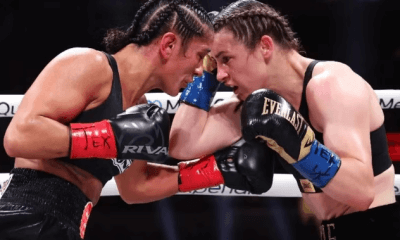
 Featured Articles3 weeks ago
Featured Articles3 weeks agoResults and Recaps from New York Where Taylor Edged Serrano Once Again
-

 Featured Articles6 days ago
Featured Articles6 days agoThe Hauser Report: Zayas-Garcia, Pacquiao, Usyk, and the NYSAC
-

 Featured Articles3 weeks ago
Featured Articles3 weeks agoResults and Recaps from NYC where Hamzah Sheeraz was Spectacular
-
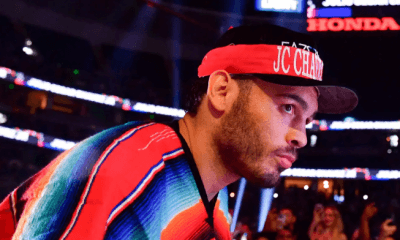
 Featured Articles4 weeks ago
Featured Articles4 weeks agoFrom a Sympathetic Figure to a Pariah: The Travails of Julio Cesar Chavez Jr
-
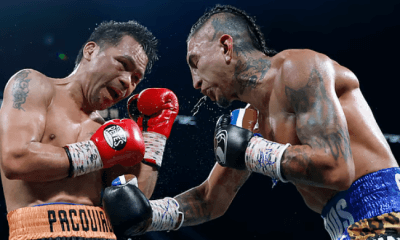
 Featured Articles2 weeks ago
Featured Articles2 weeks agoManny Pacquiao and Mario Barrios Fight to a Draw; Fundora stops Tim Tszyu
-
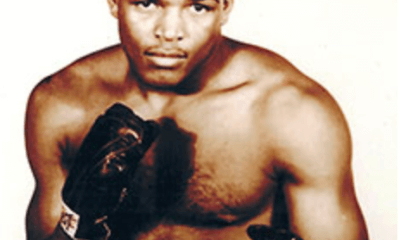
 Featured Articles3 weeks ago
Featured Articles3 weeks agoPhiladelphia Welterweight Gil Turner, a Phenom, Now Rests in an Unmarked Grave
-
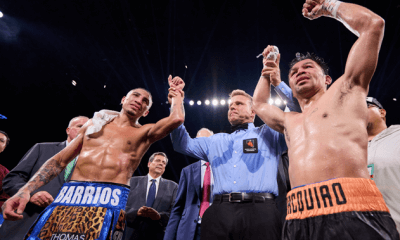
 Featured Articles2 weeks ago
Featured Articles2 weeks agoArne’s Almanac: Pacquiao-Barrios Redux
-
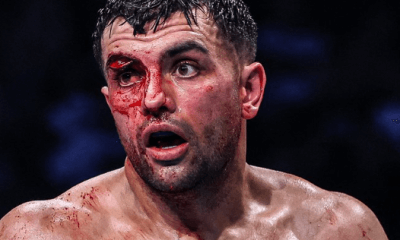
 Featured Articles4 weeks ago
Featured Articles4 weeks agoCatterall vs Eubank Ends Prematurely; Catterall Wins a Technical Decision

















